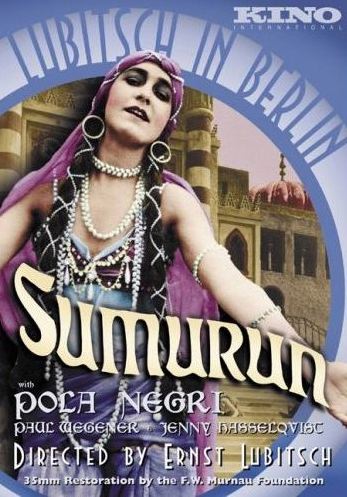
In
Ernst Lubitsch's Sumurun, from 1920, Diaghilev's Ballets Russes meets
the Keystone Kops, and the result is an inspired piece of lunacy,
slight but very entertaining.
It's yet
another variation on the mood of silliness that seemed to grip Lubitsch
in the late Teens and early Twenties — a silliness that feels quite
un-Germanic. Edgar Ulmer said of Lubitsch that “he really should
have been a Frenchman,” but Lubitsch's silliness is not quite French,
either. When a Frenchman is being silly he'll always take care to
let you know how elegant his silliness is, how artful and
respectable. Lubitsch could certainly be elegant and artful, but
he was not above using vulgarity when it took his fancy. In the
early films at least he never seems to stand on his dignity, or his
genius — he strews his effects about like flower petals, or cow pies.
In this film,
we can see the two sources of Lubitsch's early style — the broad
comedy he specialized in as a cabaret performer and the more elegant
spectacle of the theater of Max Reinhardt, for whom Lubitsch did small
character roles. Sumurun is based on a Reinhardt pantomime, and
it's full of stylish (though silly) choreography and charming scenic
effects. Lubitsch himself plays the role of a grotesque clown in
love with a dancing girl in his troupe, and offers a few examples of
his eccentric dancing along with a bigger dose of his highly stylized
acting. His performance has been criticized for its exaggeration,
but I see a lot of art in it, and the theatricality doesn't seem out of
place amidst all the artificiality of the film as a whole.
Lubitsch doesn't seem to be taking himself too seriously, even when his
character is.
The narrative
feels disjointed and is hard to follow at times, probably because the
version that survives is missing about four reels cut by its American
distributor. It hardly matters, though, because the story is not
all that important — it's just an excuse for some pleasant diversion
in an Arabian Nights vein.
Pola Negri
plays the dancing girl mentioned above, and she's a real
revelation. I guess she's technically playing a vamp here, a
dancer who drives men mad, but she plays her with all the freshness and
spunk of a Kansas farm girl or Broadway hoofer. (She seduces the
Mighty Sheik with what look like cheerleading routines.) She
seems more like a flapper than an exotic femme fatale and she gives the
film a cheerful tone that matches Lubitsch's blithe approach to the
material. She must have been a breath of fresh air to film-goers
used to the ponderous dignity, and dignified poundage, of traditional
European divas.
mardecortésbaja.com
A Journal Of Visual Culture
